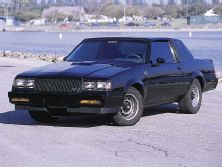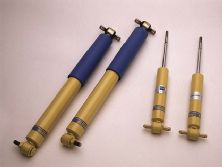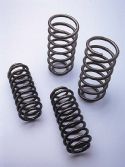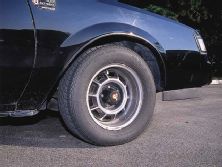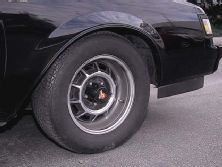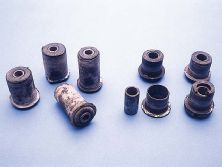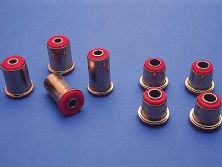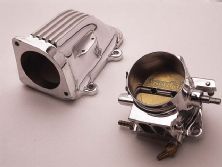Our new Buick project vehicle is registered and officially in action. Since the car was acquired in Las Vegas and black jack is my main game, we have decided to call the ongoing series "Project Black Jack."
Once back in Southern California, our first stop was Lou's Auto Service. We elected to remove the ATR seventh injector set-up because the level of the engine's modification did not really need the additional fuel. We were also a bit wary about relying on the intake design to properly distribute the fuel. This product was designed in the early 1990s and since its inception, both fuel injector availability and chip tuning have come a long way. If and when we need more fuel, we will go with a pump and bigger injectors.
Like any enthusiast, a lowered suspension was definitely in the cards. In driving the car, we noted time (not mileage) had taken its toll on the stock shocks. The car bounced a bit more than we'd like and the steering wheel tended to shimmy, suggesting something was up with the front suspension.
The wheels on the car had seen better days. The fronts had a lot of weights on them and a rear wheel had been bent and banged out. We plan to upgrade to 16-inch stock in the near future and may upgrade again when we address the brakes.
To keep things simple, we elected to replace the shocks and add a set of Eibach lowering coils. The Eibach Pro Kit springs we are using have been designed to provide stock ride characteristics while delivering a moderate 1-inch drop in the rear and a 0.8-inch drop up front. The Pro Kit line provides the mildest drop.
For those wanting 1.75-to 2.25-inches of drop, Eibach manufacturers Sportline Kits. For drag racers, Eibach has its Drag Launch kits. Intended for straight-line acceleration, the kits have been designed for both front- and rear-drive applications. Eibach's Road race kits are wound for the track and are deemed too hard for street use. It should be noted that Eibach is much more than springs; the company offers anti-roll kits (sway bars), Pro control bars (sway bars) and Pro dampers (shocks and struts).
There are a lot of shock manufacturers out there, but our research has shown that Bilstein makes the preferred shock when it comes to Turbo Regals. The Bilstein's excellent ride and handling abilities can be traced to its gas shock technology.
It should be noted that gas shocks are not strictly gas operated. There are two chambers in the shock. One chamber is filled with oil and the second is pressurized with nitrogen gas (350 psi in our Bilsteins). The shock piston moves through the oil as it does in all shocks, but the piston divides the chambers, so the more it moves in the oil chamber, the less room there is in the gas chamber. This further compresses the gas. The gas comes into play by returning the shock to its "normal" operating position quicker than a no-gas shock. This quicker reaction makes for a more responsive suspension. A byproduct of the gas is its effects on cavitation or foaming of the oil, which can hinder performance. The pressure behind the piston reduces the chance of cavitation.
The shocks and springs were installed at Eibach's U.S. headquarters in Irvine, Calif. During the install, we found out what the aforementioned shimmy was; our front control arm bushings were worn. In fact, one was practically non-existent--the rear-ward upper bushing on the passenger side. This turn of events led us to Energy Suspension. The Regal's rubber bushings are prone to weaken quickly, but Energy Suspension's urethane units provide a long service life and firmer, more responsive steering feedback. It is also no secret the body bushings on Turbo Regals are questionable. The question is not quality, but whether they were all installed at the factory. Most Turbo Regals are missing what is called the GNX bushing or the No. 5 bushing. There are six body mounting points per side on the Regal and the deleted No. 5 bushing is just in front of the rear axle. Some cars have steel washers, not bushings in positions No. 3 and No. 4. These areas should be checked while making suspension plans. We elected to replace only the upper and lower control arm bushings.
The way our battery of mods came together afforded us the chance to drive the car a little at each stage. From stock to Bilstein/Eibach to Energy bushings, there were notable improvements every step of the way. Our Bilsteins (front B36-0949, rear B46-0929) hit the mark and were a perfect match with the Eibach Pro-Kit springs. It was a real win-win situation--the GN handled better and looked better. Prior to the mods, the car felt like it was on stilts; there was an uneasy feeling when taking corners even at moderate speeds.
With the Bilstein/Eibach tag team in place, the Buick navigated rough sections of road with more authority and felt more confident going around corners. Since the suspension was tightened down, the shimmy was not as pronounced, but it was still there. After getting the car back from Energy Suspension, the difference was more noticeable than we had expected. The Buick was more solid from top to bottom and tracked more smoothly going down the road.
From here we plan to add Hotchkis trailing arms and anti-roll bars, the ultimate g-force therapy for the G-Body. Many feel a G-Body can't handle, but we learned otherwise when we employed the Hotchkis touch on our other Buick. We are also contemplating a "Dyno Cell" article that addresses whether or not power can be gained between the intercooler and the intake manifold. Stay tuned.

